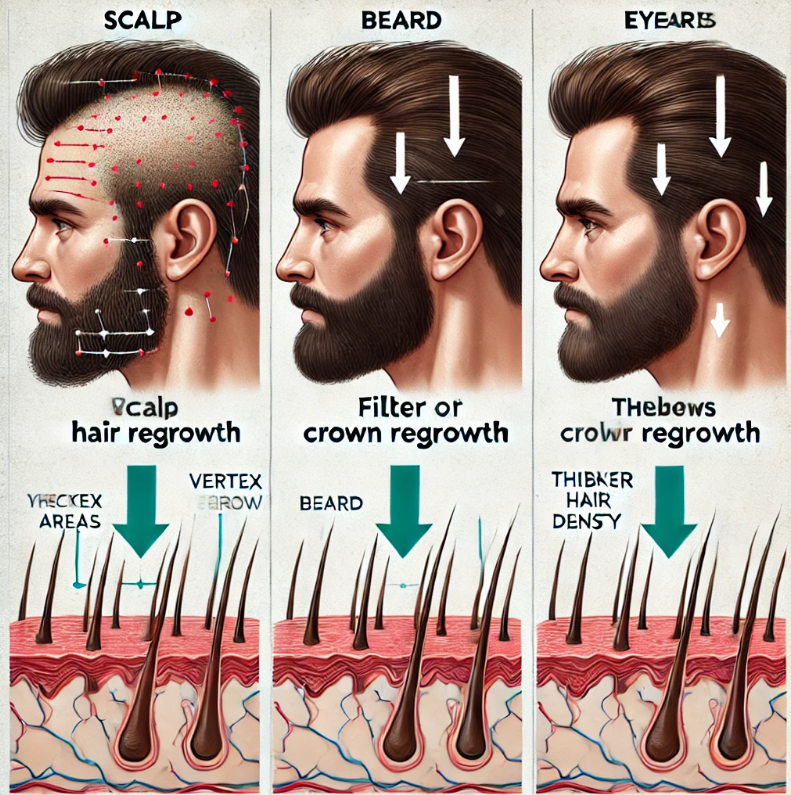Minoxidil is effective for promoting hair growth in different areas, but its effectiveness varies depending on the region—scalp, beard, or eyebrows—due to differences in hair follicle characteristics and hair growth patterns.

1. Scalp (Androgenetic Alopecia):
- Effectiveness:
- Minoxidil is most commonly used for scalp hair loss, particularly in cases of androgenetic alopecia(male and female pattern baldness). It works best on the vertex (crown) of the scalp and mid-scalp, areas where follicles are more likely to respond to stimulation.
- It is less effectivein the front hairline or areas of complete baldness because follicles in these regions may be more resistant or inactive.
- Timeframe:
- Results typically take 3 to 6 monthsto become noticeable, with more significant changes after 12 months of continuous use.
- Key Considerations:
- Continuous application is necessary to maintain results. Stopping treatment leads to hair loss resuming within a few months.
- Minoxidil does not reverse hair loss caused by scarring or other non-genetic causes.
2. Beard:
- Effectiveness:
- Minoxidil can be effective in promoting hair growth in the beard area, especially for those with patchyor uneven beard growth. The follicles in the beard area respond similarly to those on the scalp, though results can be less predictable due to variations in follicular density.
- It may help stimulate vellus hairs(fine, thin hairs) in the beard area to become terminal hairs (thicker, darker, fully developed hairs).
- Timeframe:
- Beard growth from minoxidil may take 4 to 6 monthsto show noticeable changes, with some users seeing improvements in density and fullness within a year.
- Key Considerations:
- The beard follicles tend to be slower to respond than scalp follicles, so patience is required.
- Some users experience skin irritationwhen applying minoxidil to the face, but this can often be managed with moisturizing and choosing a foam version rather than the liquid formula.
3. Eyebrows:
- Effectiveness:
- Minoxidil can also be used on eyebrowsto improve density and fill in thin or patchy areas, though results vary. Eyebrows have a shorter hair growth cycle than the scalp or beard, so regrowth is often slower.
- It can help extend the anagen phase of eyebrow hair, leading to fuller and thicker brows over time.
- Timeframe:
- Noticeable results in eyebrow growth may take 3 to 6 monthsbut tend to be subtler than on the scalp or beard.
- Key Considerations:
- Applying minoxidil to eyebrows should be done with caution to avoid contact with the eyes, as it can cause irritation or serious side effects if it enters the eye.
- Like the beard area, patchinessis often addressed first, and results vary greatly between individuals.
Important Considerations Across All Areas:
- Consistency is Key: Daily or twice-daily application is required to see results, and treatment must be continued long-term to maintain the new growth.
- Side Effects: Common side effects include itching, irritation, and dryness, especially when used on sensitive areas like the face or near the eyes.
- Permanent Results: While minoxidil can stimulate growth in these areas, stopping treatment usually results in the loss of new hairover time as the follicles return to their original state.
Summary of Effectiveness:
| Area |
Minoxidil Effectiveness |
Timeframe for Results |
Challenges |
| Scalp |
Very effective for vertex, less so for frontal hairline |
3-6 months, optimal at 12 months |
Must continue long-term; less effective in completely bald areas |
| Beard |
Effective for patchy or uneven growth |
4-6 months, full results after 12 months |
Slower response; potential for skin irritation |
| Eyebrows |
Moderate effectiveness for filling in |
3-6 months |
Caution needed to avoid contact with eyes; subtle results |
Minoxidil can be a versatile option for stimulating hair growth in multiple areas, but the level of effectiveness depends on individual hair characteristics, the area treated, and consistency in use.
